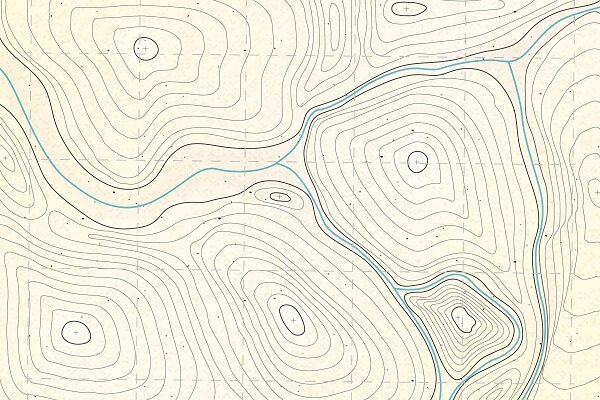Imagine planning your dream home, a major development, or an epic garden, only to realise mid-way through construction that the land's slope requires unexpected and costly adjustments.
This scenario, and many others, can be easily avoided thanks to a simple contour survey. A contour survey maps the topography of a property, depicting hills, troughs, and contours of the land.
Whether you're building a home, developing a block, or simply landscaping, understanding the topography of your property through a contour survey can save you time, money, and headaches.
What is a contour survey?
A contour survey, sometimes called a topography or level survey, measures the contours of a property, showing elevations and depressions through a series of lines, as the below example shows:

Image: freepik
Do you need a contour survey?
An area’s topography is an integral consideration when building on or developing a site.
Generally speaking, it’s cheaper to build on a flat block than it is on a sloped one, and the steeper the slope, the more expensive the build may be.
If an area is uneven, builders and developers might need to fill in patches or create retaining walls in order to create a more usable site, or take waterflow into account when planning a project.
For that reason, getting a contour survey done on your property could help you plan your build, with the help of engineers, architects, and builders.
It could also save you time and money, and may even be key to ensuring your development or build meets regulatory requirements.
Even if you’re not building or developing, a contour survey could prove invaluable when landscaping your property or building a pool, for instance.
There are many instances in which a property owner might find use in having a contour survey. Here are just a few:
-
Development
Whether you’re planning the position of lots, designing roads, setting up drainage systems, or creating community areas, a contour survey can help you make the most of your land. A contour survey is also commonly needed in order to gain development approval, so you mightn’t have a choice in whether you pursue one or not.Getting a contour survey could be the first step to designing each lot and organising for earthworks to occur, particularly if the land being developed is sloped, hilly, or prone to flooding.
-
Building
If you’re planning to build on a slope or hill, it’s wise to provide a contour survey to builders during the tendering process so they can give you a more accurate quote.It can help you determine early on whether you’ll need to fill parts of your lot, create retaining walls, elevate your home, or build a split-level dwelling.
A contour survey can also help with site planning, determining the best spots for your foundation, and ensuring water flows properly around your structures to keep everything stable and dry.
-
Landscaping
A contour survey could help you design irrigation systems, create ideal garden beds, and build features like retaining walls and terraces.If you live in an area that gets a lot of rain or your property has a stream running through it, a contour survey could help you best manage water flow as well.
-
Farming & conservation
A contour survey can also come in handy if you’re planning on growing things, such as crops, on a property.Knowing the lay of the land can also help you best plan how to conserve soil, manage erosion, and maintain biodiversity.
How to read contour lines
Most Aussies can’t instantly understand what contour lines represent on a map. It takes a bit of explanation to grasp how they depict the elevation and shape of the land.
Each line represents a particular level of elevation, which is why none of the lines will intersect.
The closer the lines are to each other, the steeper the terrain, while lines that are spaced further apart indicate a gentler slope.
Contour lines that form closed loops indicate hills or depressions. If the inside of the loop is higher, it's a hill; if lower, it's a depression.
By reading these lines, one can visualise the three-dimensional shape of the land on a two-dimensional map. At least, they can after a bit of practice.
How and when is a contour survey conducted?
Contour surveys are typically conducted by a registered surveyor – particularly if it’s needed for development approval, registration, engineering, or construction purposes. Though, builders can often complete more basic surveys.
When it comes to residential developments, a contour survey is normally done alongside soil testing and might be provided to those buying lots in the development.
There are a few different ways to measure topography, and the various tools and methods are commonly used in conjunction with one another. Some include:
-
Total stations: Measure angles and distances from a fixed point to map the land
-
GPS units: Provide precise location and elevation data
-
Drones and aerial photography: Capture images and data from above
How long it takes to complete a contour survey depends on how complicated the topography being measured is and how detailed the survey needs to be.
Often the actual act of surveying is relatively fast, taking just a few hours or days, depending on the terrain and method used. However, bringing all the measurements together to create a map can be a slow process.
Though, that varies based on the method used to measure an areas’ contours. For instance, the turnaround time for a contour survey completed largely using measurements taken from drones can be a matter of days, while an old-school contour survey can take weeks.
Considering building? Check out these construction home loan deals
Are you considering building your own home? A construction home loan might be the perfect way to finance your project. Here are some of the most competitive construction mortgages on the market right now:
| Lender | Home Loan | Interest Rate | Comparison Rate* | Monthly Repayment | Repayment type | Rate Type | Offset | Redraw | Ongoing Fees | Upfront Fees | Max LVR | Lump Sum Repayment | Additional Repayments | Split Loan Option | Tags | Row Tags | Features | Link | Compare | Promoted Product | Disclosure |
|---|---|---|---|---|---|---|---|---|---|---|---|---|---|---|---|---|---|---|---|---|---|
6.18% p.a. | 6.44% p.a. | $2,575 | Interest-only | Variable | $0 | $530 | 90% |
| Promoted | Disclosure | |||||||||||
6.19% p.a. | 6.61% p.a. | $3,059 | Principal & Interest | Variable | $395 | $null | 95% | ||||||||||||||
6.39% p.a. | 6.78% p.a. | $2,663 | Interest-only | Variable | $null | $721 | 90% | ||||||||||||||
6.69% p.a. | 6.66% p.a. | $2,788 | Interest-only | Variable | $0 | $530 | 90% | ||||||||||||||
6.53% p.a. | 6.56% p.a. | $2,721 | Interest-only | Variable | $0 | $450 | 80% | ||||||||||||||
7.05% p.a. | 6.30% p.a. | $3,343 | Principal & Interest | Variable | $0 | $1,212 | 70% | ||||||||||||||
5.89% p.a. | 5.91% p.a. | $2,962 | Principal & Interest | Variable | $0 | $350 | 60% | ||||||||||||||
6.99% p.a. | 7.42% p.a. | $2,913 | Interest-only | Variable | $20 | $644 | 90% | ||||||||||||||
8.14% p.a. | 8.47% p.a. | $3,718 | Principal & Interest | Variable | $0 | $0 | 75% | ||||||||||||||
8.43% p.a. | 8.50% p.a. | $3,820 | Principal & Interest | Variable | $0 | $900 | 80% |
Photo by Iain Kennedy on Unsplash
Collections: Construction & Renovation Insights













Share